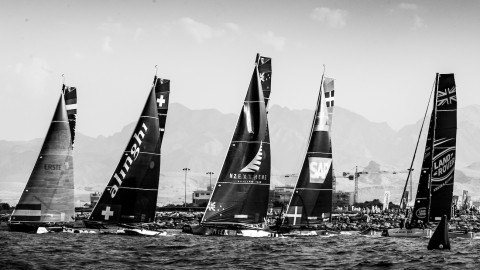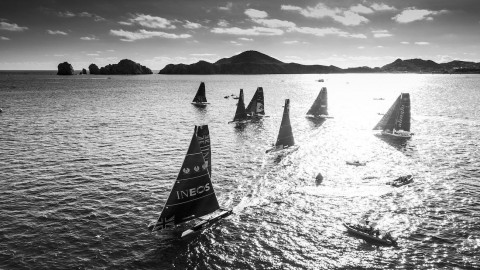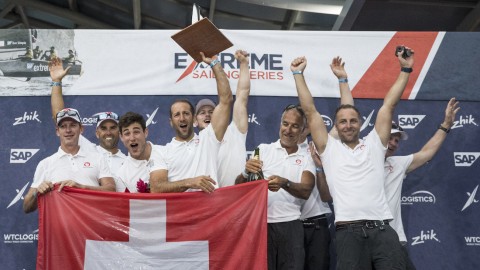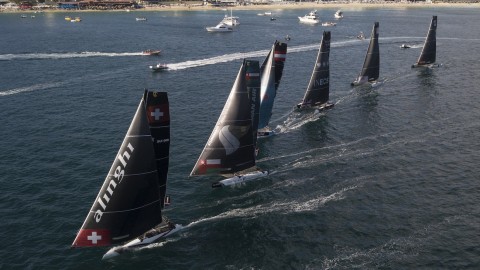Formula for success: Hamburg
We caught up with coach to some of Britain’s finest Olympic sailors and Series commentator Mark Rhodes to delve into the statistics and discover the key to success in Germany.
Friday 31st July 2015

Last week Hamburg, Germany made it into the shortlist of the best Stadium Racing venues the Extreme Sailing Series™ has visited over the last nine year. The dramatic racing played out so close to the shore you could hear the gasps from the 44,500 spectators that lined the natural grandstand over the weekend. An extremely tight racetrack, breeze from 8-30 knots, rolling thunderstorms, crashes and even a capsize meant the crews couldn’t lose focus for a moment.
Using SAP Sailing Analytics at each Act, the teams get the chance to replay the action, study their starts and see the cold hard facts on how they performed. We caught up with coach to some of Britain’s finest Olympic sailors and Series commentator Mark Rhodes to delve into the statistics and discover the key to success in Germany.
“It was great to see Gazprom Team Russian mixing it up with the big boys and finish on the podium,” explained Rhodes after an exciting week of racing. Series favourites The Wave, Muscat took their third win for 2015 but not without a fight from the Russian underdogs who pushed hard all week and finished the Act in second with SAP Extreme Sailing team in third. Looking over the analytics report Rhodes noticed: “The podium three are all very similar on stats across the board when it comes to distance to the start, speed at the start, rank at the first mark.”
Within three meters of each other on average on the line, The Wave Muscat, Gazprom Team Russia and SAP Extreme Sailing Team’s average speed at the gun only differed by 0.2 knots – with SAP Extreme Sailing Team and Gazprom Team Russia both averaging 7.6 knots.
“So what we need to do here is not only look at the stats but also at the incidents on the water and how each element of a teams performance links. The golden question is ‘what do you need to do to win’ but in a fleet this tight, one outstanding start is not going to put you at the top of the leaderboard, it’s tying them all together.“ So where did some teams go wrong? Oman Air posted the fastest speed overall at the end of the Act but lost out in their starts. SAP Extreme Sailing Team were consistently the best starters but, were unable to stay out of trouble. A dramatic capsize and crash on the start line cost them deeply on the leaderboard. And Lino Sonnego Team Italia, despite having their best Act to date, lacked the boat handling finesse to reach their full potential.
“Hamburg was a narrow race course and one of the things that really stood out was finding the strength of breeze was priority,” Rhodes adds. The main tools used by SAP Sailing Analytics are GPS modules, installed on each of the nine Extreme 40s and sensors installed on the buoys conveying live wind information. SAP Analytics are able to submit real time information on a boat’s position, boat speed, headings, distance sailed, manoeuvres and mark rounding. “We saw time and time again a team going from 18knots to 6knots and the fleet passing them and they fell into a hole in the breeze. Speed was key in Hamburg when it normally comes secondary to playing the shifts. The analytics supports this, the boat with the fastest average speed each day won.”
Gazprom Team Russia were a fine example of this posting the second highest average speed of 10.01 and the highest manoeuvres at 170 tacks and 136 gybes. On the podium from day one, the team sailed their way to second place overall. Minimise the manoeuvres and perhaps it could have been first place.
However, despite consistently in the hunt the Russians were unable to hold off Extreme 40 veterans, Leigh McMillan and The Wave, Muscat: “The thing with McMillan is you never really see him during the week, we rarely talk about him or notice him day two or three, but you get to the final day and there he is on the podium with a 10 point cushion. This shows the strength and experience in the team. The crew have that consistency, they dip in the middle of the Act but turn it on and deal with the pressure of the last day a lot better than everyone else.” The Wave, Muscat won the Act with seven race wins and nine podiums.
“McMillan will always go into that last race a strong position so it doesn’t matter where they finish in the race - they simply attack their biggest rival and that’s where SAP Extreme Sailing Team have lost out.” In the last race of the Act fans watched as The Wave, Muscat took control of SAP Extreme Sailing Team pushing them off the racecourse and subsequently down the fleet to ensure they finished the Act in third.
Always thinking of the bigger picture Rhodes explained: “Unlike all the other teams McMillan isn’t racing for the Act he’s racing for the Series. He knows exactly what his points margin is, where he needs to be, and what he needs to do. He is a good sailor with a good team, he’s a veteran of the Extreme 40s and he is in consistent control.”
SAP Analytics:
• Oman Air the fastest on average (10.02 knots)
• Team Turx sailed the shortest distance overall (out of the teams finishing all 26 races) 79.9 km
• SAP best starters: Average rank at 1st mark – 3.35 and fastest on start signal – 7.63 knots
• The Wave, Muscat are the fastest downwind – 12.12 knots
• Gazprom Team Russia are the fastest upwind – 9.38 knots
• Red Bull Sailing Team have the fewest maneuvers, Gazprom Team Russia have the most (still ranked 2nd overall)
• 16 podiums and 7 wins for The Wave, Muscat
• Red Bull Sailing Team are the closest to the startline on average (13 m)





